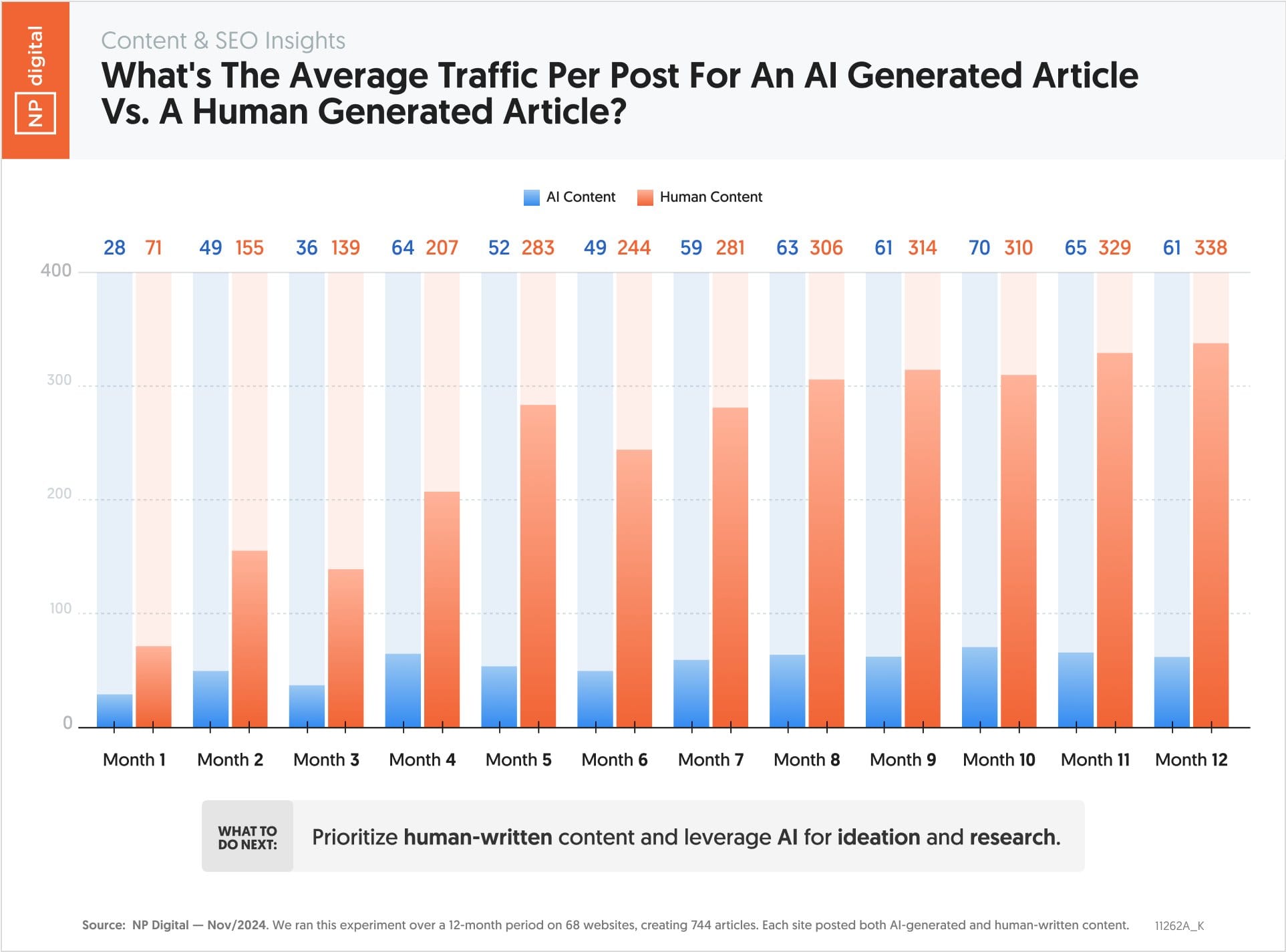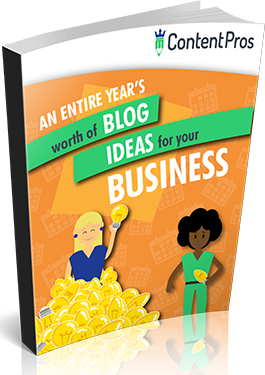Blogging remains a powerful marketing tool in 2025. But the bar is creeping ever higher if you want people to do more than read your content. Keywords, backlinks, and search intent aren’t enough anymore.
The art of blogging has always been in constant flux. But over the last 10 years, these changes have been ripple effects compared to the incoming tsunami in 2025. With the influx of AI content, Google’s leaked algorithm in 2024, and a new search engine experience, blogging is getting a major upgrade — and now is the time to adapt your strategy.
Let’s review some of the newest trends that are redefining blogging as we know it and how you can leverage them to your advantage.
Skip ahead to the top blogging trends of 2025:
Blogging Trend #1: The AI Takeover: Content Wave Incoming
More than 3 in 4 content marketers are using AI for basic content creation. They’re producing a much larger volume of content in less time, at a faster pace, and at a lower cost. That’s the perfect storm for a content tsunami, which increases competition for visibility.
But there’s a catch.
More content made faster and cheaply doesn’t mean better content. It also doesn’t guarantee effective content. And there’s data to prove it:

AI-generated articles simply aren’t getting traction online. At least not as much as their human-written counterparts.
Human-driven copy still dominates, which is good news for bloggers. This is an opportunity to get ahead of the tidal wave of robotic, emotionless content that other marketers are churning out.
There are never guarantees in blogging, but the data makes a compelling case for writing your own copy or outsourcing it to a blogging agency. Paying for high-quality content will be worthwhile in the long run since you’ll likely get more eyes on it.
Blogging Trend #2: Google’s Leaked Algorithm Guidelines
In 2024, Google “leaked” some algorithm specifics that marketers had long suspected but could never confirm. These included:
- Clicks, domain authority, site age, and backlinks matter.
- Some signals matter more than others.
- Algorithms prioritize topical authority.
- Content length impacts rankings.
- Marketers need to keep content up to date.
And a score of other insights.
While most of the findings weren’t smoking guns, they do remind bloggers and marketers of their priorities. Confirming how the algorithms work can help tune out distractions and focus on the right activities.
Ultimately, your blogging checklist should include:
- Choosing a strong keyword to include in your title
- Drafting high-quality content and refreshing dated content
- Publishing consistently
- Building topic authority
- Earning backlinks to your site to boost domain authority
- Promoting your blog to get as many clicks as possible
This checklist has always been the foundation of blogging. Stick to the basics, master them, then grow from there.
Blogging Trend #3: The New SERP Experience (and a New Search Engine)
Have you been paying attention to how your Google search results look these days? They’re no longer a list of websites that match a query.
Google’s new SERP experience combines AI overviews, rich snippets, People Also Ask questions, paid ads, videos, and a myriad of other features — many of which appear above organic results.

Bing has its own share of SERP features that go beyond organic rankings, like a grid of results above the list of organic results.

Ultimately, this is both good news and bad news for bloggers. On the plus side, new SERP features give users more ways to discover your content. The downside, of course, is that traditional organic rankings aren’t as visible, so if you’ve historically performed well in organic search, you might need to revamp your content and processes.
It’s also worth mentioning that OpenAI, the mastermind behind ChatGPT, has unveiled a new search engine. SearchGPT’s conversational experience is drastically different from Google or Bing. Learn how to optimize for the new search rival in our post: How SearchGPT is Changing SEO (And What to Do Next).
Blogging Trend #4: Going Back to Short-Form Content
In light of shrinking attention spans and demand for quick, easy-to-digest content, short-form content is back on the menu.
Long-form content had a long moment in the spotlight because marketers viewed it as more authoritative and in-depth. It was an effective strategy to attract search algorithms and improve rankings.
But not everything needs to be a 2,000-word long blog post if you can cover the same topic in just a few paragraphs.
With the move toward AI overviews and rich snippets, short-form content can help to answer queries directly and succinctly.
But what about page dwell time, you ask?
Shorter content is quicker to consume, so yes, dwell time might be lower. But you’ll establish yourself as an authority by giving readers what they want — and not wasting their time in the process.
Blogging Trend #5: Golden Long-Tail Keywords
Keywords are becoming more competitive, which means bloggers need to be more selective about the keywords they choose.
One solution is to chase long-tail keywords, which can be SEO gold. They might not get as many searches as shorter, more generic terms. But because they’re longer, they’re usually more specific and can allude to the searcher’s intent.
When you use long-tail keywords (keywords that contain multiple words or entire phrases or sentences), you’re aligning your content with a highly specific query. This can give you a better chance of ranking for that search and adequately addressing the searcher’s needs.
Blogging Trend #6: Building Trust with Blogging
Marketers are generating a ton of AI content, and it’s affecting reader trust. They might not always recognize content that’s written with AI programs; but when they do, they’re hesitant to trust it as much as human-written copy.
This presents a golden opportunity for bloggers and marketers to set new standards for trust. For instance, if you’re not using AI to write your blogs, say so. And if you are publishing AI-written copy, say so. Your readers will appreciate the transparency either way.
You can also build trust in your content by:
- Linking to high-quality sources
- Using descriptive anchor text that matches the link
- Adding a list of sources as a footnote
- Using only recent sources or data
- Linking to original data sources
- Having an industry expert peer review your content
These aren’t necessarily new rules of blogging, but their importance is growing in the era of AI content.
Blogging Trend #7: TL;DR Summaries
Short attention spans mean readers don’t want to waste time reading content that doesn’t address their needs or otherwise doesn’t interest them. Adding summaries or key takeaways to the top of articles offers a solution, and doing so benefits readers and search algorithms alike.
Too long, didn’t read (TL;DR) summaries give readers an idea of what the article is about. They can take the form of bullet points, a couple of sentences, or a table of contents with links to each section of the article.
Since these shortcuts are at the top of the post, they’re the first things search algorithms read. Algorithms don’t read entire blog articles; instead, they rely on good titles, introductions, and headings to learn what your content is about and how to rank it in search results. Summaries can help with SEO by providing a glimpse into the rest of your article.
A good TL;DR summary will include the primary keyword as early as possible, cover the main points of the article, and set the reader’s expectations.
Succeeding in a New Era of Blogging
Blogging in 2025 is changing for the better and giving marketers plenty of new opportunities to reach their audience. Blogs thrive on organic search, and with new SERP experiences, marketers have more ways to get in front of readers.
Quality content serves as the common thread to these seven blogging trends for 2025. Blogs that address readers’ queries, are easy and engaging to read, cater to the user experience, and earn instant trust will outperform lesser content every time.
Get in touch if you’d like to get better results from your blog in 2025.

